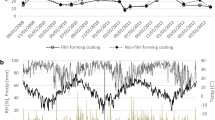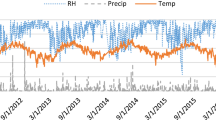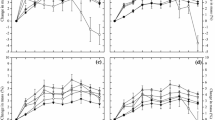Abstract
Coated and uncoated specimens of fast-grown and slow-grown Norway spruce (Picea abies (L.) Karst) were subjected to water exposure according to the European standard EN 927-5, but with prolonged exposure time. The modified EN 927-5 method can be used to evaluate the performance of wood types in combination with coatings regarding liquid water uptake. A significant effect of wood type was only found after four weeks of exposure or more, indicating that the flux of water through a coating is unaffected by differences in spruce wood properties during the exposure time specified in the standard. Regarding coated specimens slow-grown spruce absorbed more water, but the resulting moisture content gain was higher in fast-grown spruce. The performances of the coatings relative to each other were similar within each wood type. With respect to uncoated reference specimens, fast-grown spruce absorbed the largest amounts of water. The same was found for moisture content gain.
Zusammenfassung
Beschichtete und unbeschichtete Prüfkörper aus schnell wachsendem und langsam wachsendem Fichtenholz (Picea abies (L.) Karst) wurden gemäß EN 927-5 flüssigem Wasser ausgesetzt, allerdings über eine längere Zeitspanne als in der Norm angegeben ist.
Die so modifizierte Standardmethode kann zur Untersuchung des Wasseraufnahmeverhaltens von beschichteten Holzarten herangezogen werden. Ein signifikanter Einfluss der Wuchsgeschwindigkeit konnte erst nach einer Wasserlagerung von vier Wochen oder länger festgestellt werden. Dies zeigt, dass die Wasserdurchlässigkeit der Beschichtung während der in der Norm vorgegebenen Einwirkungsdauer durch unterschiedliche Holzeigenschaften nicht beeinflusst wird. Bei den beschichteten Prüfkörpern nahm das Holz langsam wachsender Fichte mehr Wasser auf, allerdings stieg die Holzfeuchte bei Holz der schnell wachsenden Fichte stärker an. Das Verhalten der einzelnen Beschichtungen war bei beiden Holztypen ähnlich. Bei den unbeschichteten Kontrollproben waren die Wasseraufnahme und die Zunahme der Holzfeuchte bei den Proben aus schnell wachsender Fichte größer als bei denen aus langsam wachsender Fichte.




Similar content being viewed by others
References
Ahola P (1991) Moisture transport in wood coated with joinery paints. Holz Roh- Werkst 49(11):428–432
Ahola P, Derbyshire H, Hora G, de Meijer M (1999) Water protection of wooden window joinery painted with low organic solvent content paints with known composition. Part 1. Results of inter-laboratory tests. Holz Roh- Werkst 57(1):45–50
Bergström M, Blom A (2007) Differences in properties between Norway spruce (Picea abies) heartwood and sapwood. Part 2. Vapour and Liquid permeability. In: Proceedings of the wood protection conference, March 21–23, 2006. Forest Products Society, New Orleans
EN 927-5 (2000) Paints and varnishes—Coating materials and coating systems for exterior wood—Part 5: Assessment of the liquid water permeability. European Committee for Standardization, Brussels
Choong ET, Shupe TF, Chen Y (1999) Effect of steaming and hot-water soaking on extractive distribution and moisture diffusivity in southern pine during drying. Wood Fiber Sci 31(2):143–150
de Meijer M (2001) Review on the durability of exterior wood coatings with reduced VOC-content. Prog Org Coat 43(4):217–225
de Meijer M (2002) Comparison between laboratory water permeability tests and wood moisture content of full-scale window frames. Surf Coat Int, B Coat Trans 85(2):131–137
de Meijer M, Creemers J, Cobben W (2001) Relationships between the performance of low-VOC wood coatings and the dimensional changes of the wooden substrate. Surf Coat Int, B Coat Trans 84(1):77–85
de Meijer M, Militz H (2000a) Moisture transport in coated wood. Part 1: Analysis of sorption rates and moisture content profiles in spruce during liquid water uptake. Holz Roh- Werkst 58(5):354–362
de Meijer M, Militz H (2000b) Moisture transport in coated wood. Part 2: Influence of coating type, film thickness, wood species, temperature and moisture gradient on kinetics of sorption and dimensional change. Holz Roh- Werkst 58(6):467–475
de Meijer M, Thurich K, Militz H (1998) Comparative study on penetration characteristics of modern wood coatings. Wood Sci Technol 32(5):347–365
Derbyshire H, Miller ER (1996) Moisture conditions in coated exterior wood. Part 1: An investigation of the moisture transmission characteristics of exterior wood coatings and the effect of coating on moisture permeability. J Inst Wood Sci. 14(1):40–47
Derbyshire H, Miller ER (1997) Moisture conditions in coated exterior wood. Part 2: The relation between coating permeability and timber moisture content. J Inst Wood Sci. 14(4):162–168
Derbyshire H, Robson DJ (1999) Moisture conditions in coated exterior wood—Part 4: Theoretical basis for observed behaviour. A computer modelling study. Holz Roh- Werkst 57(2):105–113
Eaton RA, Hale MDC (1993) Wood. Decay, pests and protection. Chapman&Hall, London, 469 p
Ekstedt J (2003) Influence of coating system composition on moisture dynamic performance of coated wood. J Coat Technol 75(938):27–37
Ekstedt J, Östberg G (2001) Liquid water permeability of exterior wood coatings-testing according to a proposed European standard method. J Coat Technol 73(914):53–59
Feist WC (1985) The moisture-excluding effectiveness of finishes on wood surfaces. Forest Products Laboratory, 38 p
Feist WC (1990) Outdoor wood weathering and protection. Adv Chem Ser 225:263–298
Forest Products Laboratory (1987) Wood handbook: wood as an engineering material. US Department of Agriculture, Washington, 466 p
Greystone J (2001) Moisture transport through wood coatings: the unanswered questions. Surf Coat Int, B Coat Trans 84(3):169–242
Greystone J, Ekstedt J (2004) Current views on the role of water in the behaviour of coated wood substrates. In: COST E18, high performance wood coating. Final seminar, Paris, 26–27 April
ISO 3130 (1975) Wood—determination of moisture content for physical and mechanical tests. International Organization for Standardization, Geneva
Liese W, Bauch J (1967) On anatomical causes of the refractory behaviour of spruce and douglas fir. J Inst Wood Sci. 19:3–14
Longuetaud F, Mothe F, Leban JM, Makela A (2006) Picea abies sapwood width: variations within and between trees. Scand J For Res 21(1):41–53
Metsa-Kortelainen S, Antikainen T, Viitaniemi P (2006) The water absorption of sapwood and heartwood of Scots pine and Norway spruce heat-treated at 170°C, 190°C, 210°C and 230°C. Holz Roh- Werkst 64(3):192–197
Nussbaum RM, Sutcliffe EJ, Hellgren AC (1998) Microautoradiographic studies of the penetration of alkyd, alkyd emulsion and linseed oil coatings into wood. J Coat Technol 70(878):49–57
Rapp AO, Peek R-D, Sailer M (2000) Modelling the moisture induced risk of decay for treated and untreated wood above ground. Holzforschung 54:111–118
Rijckaert V, Stevens M, Van Acker J, de Meijer M, Militz H (2001) Quantitative assessment of the penetration of water-borne and solvent-borne wood coatings in Scots pine sapwood. Holz Roh- Werkst 59(4):278–287
Rijsdijk JF, Laming PB (1994) Physical and related properties of 145 timbers: information for practice. Kluwer Academic, Dordrecht, 380 p
Roux ML, Wozniak E, Miller ER, Boxall J, Böttcher P, Kropf F, Sell J (1988) Natural Weathering of Various Surface-Coatings on five Species at four European Sites. Holz Roh-Werkst 46(5):165–170
Salin J-G (2008) Modelling water absorption in wood. Wood Mater Sci Eng 3(3):102–108
Sandberg K (2006) Modelling water sorption gradients in spruce wood using CT scanned data. NZ J For Sci 36(2–3):347–364
Sehlstedt-Persson M (2001) The effect of extractive content on moisture diffusion properties for Scots pine and Norway spruce. In: COST Action E15 advances in the drying of wood (1999–2003). Proceedings of the 3rd workshop on softwood drying to specific end-uses, Helsinki, Finland, 11–13 June
Sell J (1975) Grundsätzliche Anforderungen an Oberflächenbehandlingen für Holz im Außenbau (Literaturübersicht). Holz Roh- Werkst 33(9):336–340
Sivertsen MS, Vestøl GI (2010) Liquid water absorption in uncoated Norway spruce (Picea abies) claddings as affected by origin and wood properties. Wood Mater Sci Eng 5(3):181–193
Söderström O, Salin JG (1993) On determination of surface emission factors in wood drying. Holzforschung 47:391–397
Tong L (1989) Moisture diffusivities and sorption isotherms of Swedish spruce and pine. TRITA-BYMA 1989:8. Dep of Building Materials, The Royal Institute of Technology, Sweden, 60 p
Virta J, Koponen S, Absetz I (2006) Modelling moisture distribution in wooden cladding board as a result of short-term single-sided water soaking. Build Environ 41(11):1593–1599
Voigt H, Kirscher O, Schauss H (1940) Die Feuchtigkeitsbewegung bei der Verdunstungstrocknung von Holz. Holz Roh- Werkst 3(10):305–321 (in German)
Wadsö L (1993a) Measurements of water-vapour sorption in wood. 2. Results. Wood Sci Technol 28(1):59–65
Williams RS, Feist WC (1994) Effect of preweathering, surface-roughness, and wood species on the performance of paint and stains. J Coat Technol 66(828):109–121
Williams RS, Jourdain C, Daisey GI, Springate RE (2000) Wood properties affecting finish service life. J Coat Technol 72(902):35–42
Williams RS, Winandy JE, Feist WC (1987) Paint adhesion to weathered wood. J Coat Technol 59(749):43–49
Zabel RA, Morrell JJ (1992) Wood microbiology: decay and its prevention. Academic Press, San Diego, 476 p
Øvrum A (2002) Wood focus no 22. External cladding. 2nd revised edn. Norsk Treteknisk Institutt, Oslo (in Norwegian)
Acknowledgements
Sigrun Kolstad (The Norwegian Forest and Landscape Institute) and Bjørn Slette (Norwegian University of Life Sciences) are gratefully acknowledged for participating in the weighing of the specimens. Knut Magnar Sandland (Treteknisk) is greatly acknowledged for reading and commenting on a preliminary version of the manuscript. Funding from The Research Council of Norway is greatly acknowledged as well.
Author information
Authors and Affiliations
Corresponding author
Rights and permissions
About this article
Cite this article
Sivertsen, M.S., Flæte, P.O. Water absorption in coated Norway spruce (Picea abies) cladding boards. Eur. J. Wood Prod. 70, 307–317 (2012). https://doi.org/10.1007/s00107-011-0557-8
Received:
Published:
Issue Date:
DOI: https://doi.org/10.1007/s00107-011-0557-8




